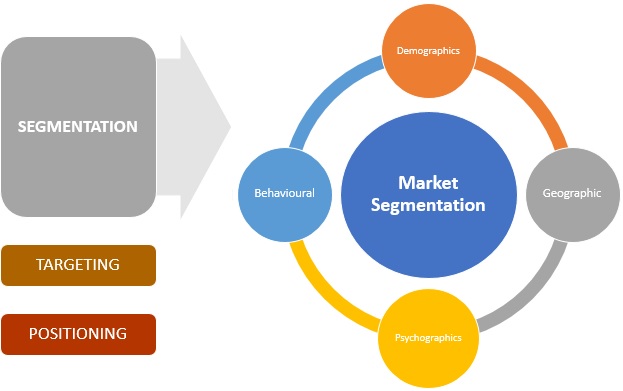Objectives
In this lesson, we will introduce you to the activities, viz., segmentation, targeting and positioning, that are collectively referred to as marketing strategy. After you work out this lesson, you should be able to:
· Segment the markets based on several segmentation variables
· Target a segment by identifying the fit between segment profitability and organizational capability
· Position your product/service so that it occupies a distinct and valued place in the target customers’ minds
In this lesson, we will discuss the following:
· The logic of segmentation
· Segmentation analysis
· Segmentation variables for consumer markets and industrial markets
· Targeting approaches
· Positioning identities
· Differentiation across the consumption chain
Introduction
Development of a successful marketing strategy begins with an understanding of the market for the good or service. A market is composed of people or institutions with need, sufficient purchasing power and willingness to buy. The market place is heterogeneous with differing wants and varying purchase power. The heterogeneous marketplace can be divided into many homogeneous customer segments along several segmentation variable. The division of the total market into smaller relatively homogeneous groups is called market segmentation. Products seldom succeed by appealing to everybody. The reasons are simple: not every customer is profitable nor worth retaining, not every product appeals to every customer. Hence the organizations look for a fit between their competencies and the segments’ profitability. The identified segments are then targeted with clear marketing communications. Such communications are referred to as positioning the product or service in the mind of the customer so as to occupy a unique place. This involves identifying different points of differentiation and formulating a unique selling proposition (USP). In today’s marketplace, differentiation holds the key to marketing success. This lesson is about marketing strategy formulation which consists of market segmentation, targeting and positioning.
The logic of Segmentation
The concept of market segmentation has helped marketing decision making since the evolution of marketing. The goal of market segmentation is to partition the total market for a product or service into smaller groups of customer segments based on their characteristics, their potential as customers for the specific product or service in question and their differential reactions to marketing programs. Because segmentation seeks to isolate significant differences among groups of individuals in the market, it can aid marketing decision making in at least four ways:
1. Segmentation helps the marketer by identifying groups of customers to whom he could more effectively ‘target’ marketing efforts for the product or service
2. Segmentation helps the marketer avoid ‘trial-and-error’ methods of strategy formulation by providing an understanding of these customers upon which he can tailor the strategy
3. In helping the marketer to address and satisfy customer needs more effectively, segmentation aids in the implementation of the marketing concept
4. On-going customer analysis and market segmentation provides important data on which long-range planning (for market growth or product development) can be based.
Although it is a very useful technique, segmentation is not appropriate in every marketing situation. If, for instance, a marketer has evidence that all customers within a market have similar needs to be fulfilled by the product or service in question (i.e. an undifferentiated market), one ‘mass’ marketing strategy would probably be appropriate for the entire market. However, in today’s market environment, it is unlikely that one would find either an entirely homogeneous market.
Segmenting the Consumer Markets
Consumer markets are those where the products are purchased by ultimate consumers for personal use. Industrial markets are those where the goods and services are purchased for use either directly or indirectly in the production of other goods and services for resale. Market segmentation of these markets use different variables. The consumer market segmentation variables appear to fall into two broad classes: consumers’ background characteristics and consumers’ market history. The following tables illustrate the most important factors and variables that have been found useful for market segmentation.
Table 1 Segmentation using consumer background characteristics

Table 2 Segmentation using consumers’ market history


Segmenting the Industrial Markets
Industrial marketing needs to consider two important sets of characteristics of the business buyers: (1) the characteristics of the buyer as a consuming organization and (2) the behavioural characteristics of the buyer. The first set includes such factors as the type of the organization, the size, the product requirements, the end use of the product, the organization capabilities and so on. The second set includes factors like the buying decision making process and considers the fact that it is in effect people and the organization, who take the decision. These characteristics have led to a two-stage approach to industrial market segmentation starting with a macro segmentation and then going into a micro segmentation. Between the macro and micro bases of industrial market segmentation, there lie some useful bases of segmentation, as suggested by Shapiro and Bonoma in the Nested approach to segmenting the industrial markets. These intermediate bases of segmentation, viz., demographics, operating variables, purchasing approaches, situational factors and personal characteristics, are explained in Table 3. The table lists major questions that business marketers should ask in determining which customers they want to serve. By targeting these segments instead of the whole market, companies have a much better chance to deliver value to customers and to receive maximum rewards for close attention to their needs.
Table 3 Major Segmentation variables for Industrial Markets




